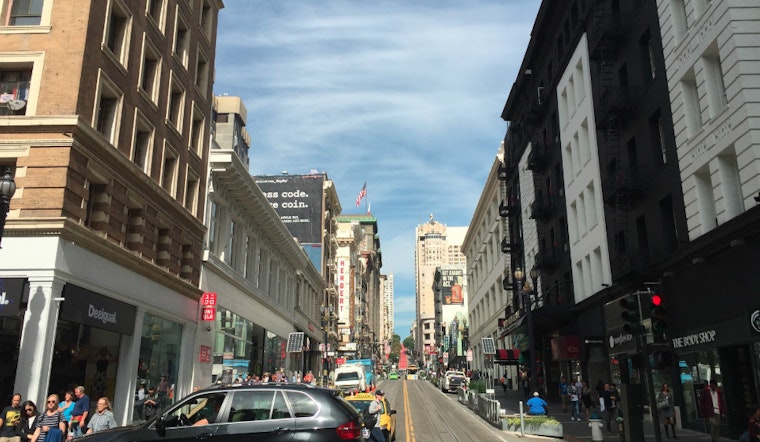
The Union Square Business Improvement District hosted an open house on Thursday with the SFMTA, to explain its revised plan for closing part of Powell Street. In response to concerns from area businesses, the closur will still allow access for commercial vehicles, taxis and passenger pick-ups and drop-offs at hotels.
The Powell Street Safety and Sidewalk Improvement Pilot will close Powell between Geary and Ellis streets (the 100-200 blocks) to most traffic for 18 months, beginning in early November. Depending on the outcome, SFMTA will propose making the changes permanent, possibly as early as mid-2018.
Some vehicles will be allowed to turn onto Powell for access, including delivery trucks, shuttle vans, and vehicles taking people to or from hotels on the 200 block of Powell. But the overall number of vehicles will be "drastically reduced," said Sean Kennedy, Muni Forward program manager. "We still think we'll get the benefits we're looking for." He added, "We've made a lot of changes based on feedback. A lot of the community concerns have been addressed."
Here's why Muni is proposing the street closures:
- Cable car safety: Heavy traffic is causing cable cars to stop and go, leading to frayed cables. "The cable broke three different times during the month of December," Kennedy said. The SFMTA notes that "today, the cables must be replaced every 25 days on average, down from every 52 days in 2000."
- Cable car efficiency: "Traffic congestion also increases the time it takesfor a cable car to make one run, meaning Muni offers fewer cable car trips per day at agreater expense, because of the congestion in the Union Square area," according to SFMTA.
- Pedestrian safety: There have been 25 collisions on those two blocks in recent years, resulting in 18 injuries.
- A better walking environment: SFMTA posters showed pleasant pedestrian commercial zones in cities like Helsinki, Jerusalem and Zurich, and noted that more than 4,000 people per hour walk on Powell Street during peak periods.
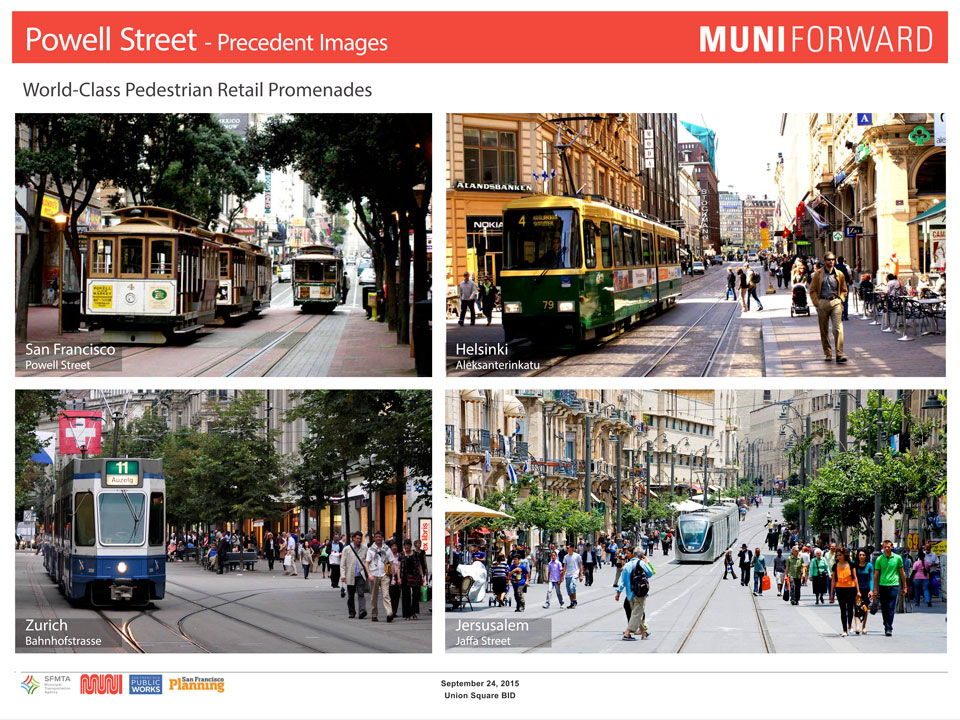
According to many case studies, a better walking environment also leads to a better business environment. "When they widened Jefferson Street, retail sales boosted 10 to 30 percent," said Karin Flood, executive director of the Union Square BID. "When you walk down the sidewalks where there aren't cars, you can really see the shops and you're more likely to patronize them."
The closure should also help, not hinder, traffic flow, because much of the gridlock around that area comes from cars attempting to turn across congested crosswalks, said project manager Dan Howard.
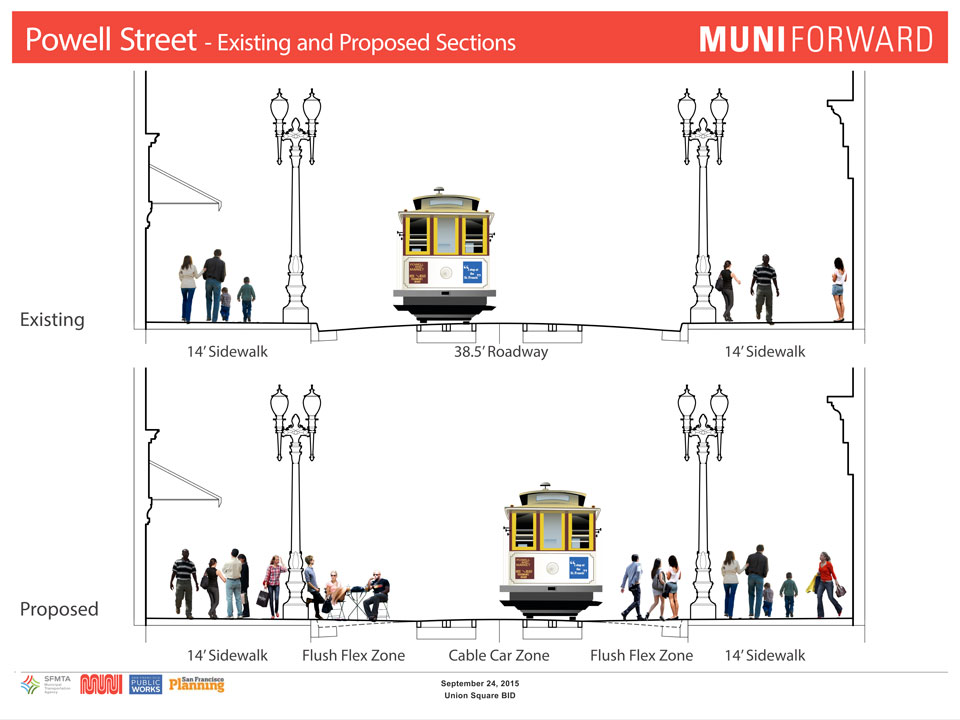
Rendering: MuniForward
Nevertheless, back in August, we reported that some area businesses had concerns about the temporary closure. Hotels on the street wanted to know where passengers would load and unload, particularly those with physical challenges. And other businesses on Powell don't have another entrance for deliveries.
"We crafted an exemption for commercial vehicles to do deliveries to Powell," Howard said. Originally, he said, SFMTA asked if deliveries could be limited to certain hours, such as early morning, but found the streets were needed 24 hours a day. Exceptions were made for passenger drop-off and pick-up for the hotels, too.
Northbound, only commercial vehicles will be allowed on the two blocks. Southbound, any vehicle making a pickup or drop-off will be allowed between Geary and O'Farrell only. "We're testing those two restrictions side-by-side," said Howard, and they'll decide after the pilot which works best. If it's found that passenger pick-up and drop-off is ineffective, the permanent closure will propose an alternative—possibly loading zones at the corners, or other ideas.

Dan Howard.
The Powell Street Promenade is another consideration. Sponsored by Audi, it replaced existing street parking and added just over six feet of sidewalk on both sides of the street from Geary to Ellis, along with new pedestrian walking surfaces, street furnishings, plantings, benches, planters, rails and photovoltaic towers. It was installed in late spring of 2011; its creators, Hood Design, won a 2012 award from the American Society of Landscape Architects for it.
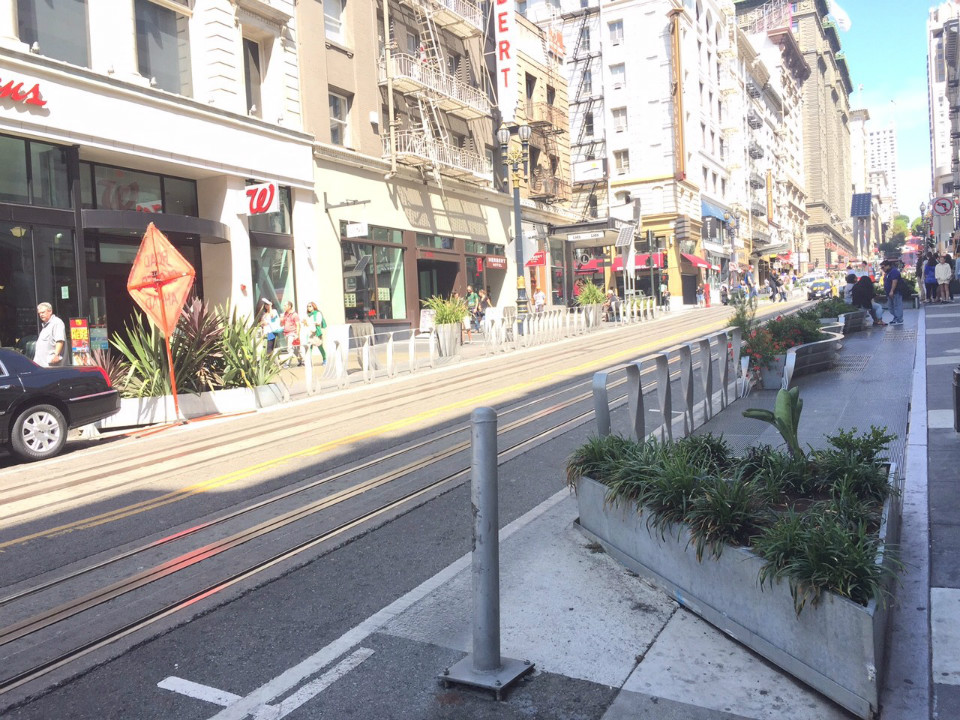
Powell Street Promenade.
However, the promenade's five-year maintenance contract, which was funded by Audi, will soon expire. So what will happen to the promenade during the pilot? Posters showed three possible scenarios: No changes, some modifications of the existing structures, or total removal. The Planning Department is leading the effort through the Pavement to Parks program, and is holding meetings with Union Square BID going forward to decide what to do in the short-term, before any permanent Powell Street changes are made.
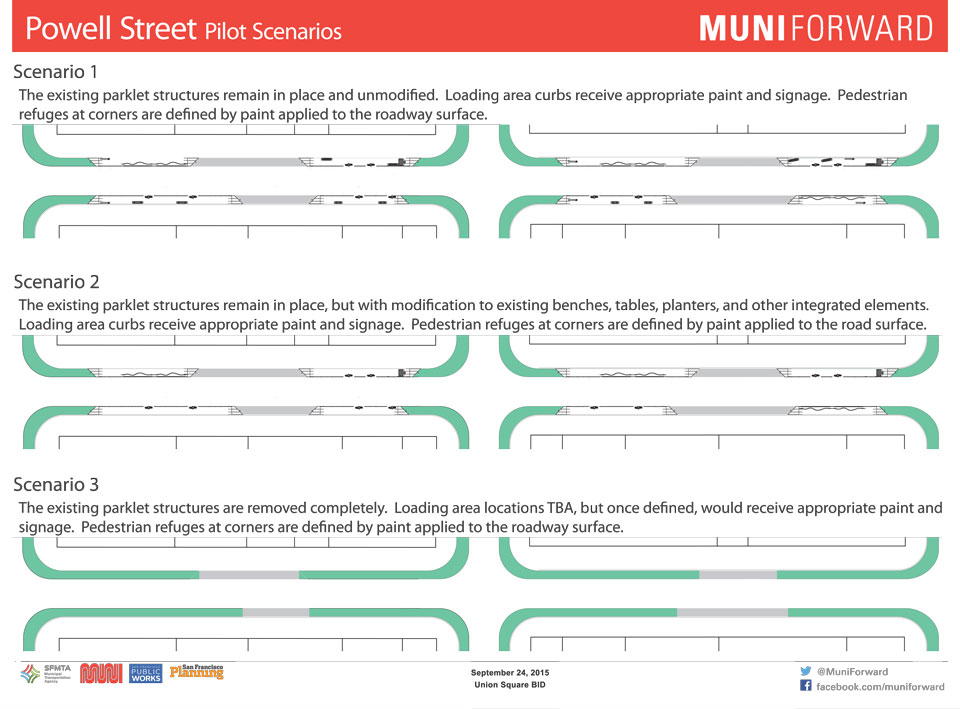
Rendering: MuniForward
The timeline for getting the street-closure pilot up and running is tight. A final public hearing in front of the SFMTA Board will be held at 1pm on Nov. 3rd in Room 400 of City Hall. Installation is slated to begin three days later, on Nov. 6th, and run through the 15th. "We want to get it in right before Thanksgiving," Howard said, "because that's when traffic really peaks around here."
During the pilot, various data will be collected, including cable-car wear, traffic violations, vehicle counts, vehicle collisions, loading studies and transit delay studies on the cable cars and Muni's 38 and 38R buses. Though the pilot will be in place for 18 months (starting in December), staff will pursue permanent legislation after the first 12 months, based on what was learned during the pilot. "We'll be able to determine whether it was effective," Howard said.
The pilot has been funded, and will cost about $500,000. A full implementation will run roughly $12 million and will require a public-private partnership; Kennedy said they're still working on funding for that.
"We have to get creative in terms of pooling public and private dollars to make it work," Flood said, noting that the BID's management plan doesn't include funding for streetscape improvement. "At the end of the day, we want to have a beautiful street that accommodates pedestrians and merchants."









